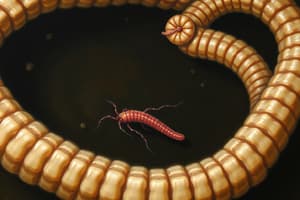Podcast
Questions and Answers
How many hookworm infections occur annually, out of which approximately 100 million are symptomatic?
How many hookworm infections occur annually, out of which approximately 100 million are symptomatic?
- 1200m (correct)
- 2000m
- 1000m
- 1500m
What is the result of the continued daily loss of 10ml of blood in a child?
What is the result of the continued daily loss of 10ml of blood in a child?
- Severe elephantiasis
- Severe lymphangitis
- Severe fever
- Severe anaemia (correct)
Which of the following species of hookworm is predominant in sub-Saharan Africa, south Asia, and the Pacific?
Which of the following species of hookworm is predominant in sub-Saharan Africa, south Asia, and the Pacific?
- Ascaris lumbricoides
- Trichuris trichiura
- Necator americanus (correct)
- Ancylostoma duodenale
In how many countries is lymphatic filariasis found?
In how many countries is lymphatic filariasis found?
In the absence of latrines, how do hookworm eggs contaminate the environment?
In the absence of latrines, how do hookworm eggs contaminate the environment?
What percentage of people infected with lymphatic filariasis are disfigured or severely incapacitated?
What percentage of people infected with lymphatic filariasis are disfigured or severely incapacitated?
What is the approximate time it takes for infective filariform larvae to develop in soil?
What is the approximate time it takes for infective filariform larvae to develop in soil?
What species of mosquito is responsible for transmitting Wuchereria bancrofti in India?
What species of mosquito is responsible for transmitting Wuchereria bancrofti in India?
How do filariform larvae penetrate the human host?
How do filariform larvae penetrate the human host?
What is the stage of lymphatic filariasis characterized by bouts of fever?
What is the stage of lymphatic filariasis characterized by bouts of fever?
What is the main cause of iron deficiency anaemia in hookworm infections?
What is the main cause of iron deficiency anaemia in hookworm infections?
What is the usual result of the chronic stage of lymphatic filariasis?
What is the usual result of the chronic stage of lymphatic filariasis?
How often do hookworms move to different attachment sites in the upper intestinal mucosa?
How often do hookworms move to different attachment sites in the upper intestinal mucosa?
Which species of hookworm ingests more blood each day?
Which species of hookworm ingests more blood each day?
What is the primary location of the adult worms in lymphatic filariasis?
What is the primary location of the adult worms in lymphatic filariasis?
What is the time period for the development of larvae into adult worms?
What is the time period for the development of larvae into adult worms?
Flashcards are hidden until you start studying
Study Notes
Hookworm
- 1.2 billion infections occur each year, with 100 million being symptomatic.
- There are two parasites that cause hookworm infections, which are found worldwide: Necator americanus and Ancylostoma duodenale.
- Necator americanus is the predominant species in sub-Saharan Africa, south Asia, and the Pacific.
- Ancylostoma duodenale is the predominant species in S.Europe, N.Africa, western Asia, northern China, Japan, and the west coast of America.
Life Cycle
- Adult worms live in the intestine and excrete eggs in the faeces.
- Eggs contaminate soil and develop in warm, damp conditions.
- Eggs hatch and infective filariform larvae develop in about one week and remain infective in soil for many weeks.
- Filariform larvae penetrate the skin when a person walks barefoot in the soil.
- Larvae migrate from the skin to the lungs via the lymphatic and blood systems.
- Larvae penetrate the capillary wall to enter the alveolus.
- Larvae are propelled up the respiratory tree to the epiglottis where they are swallowed.
- They develop to adult stage in the upper intestine, which takes about 5 weeks.
- Eggs are excreted in the faeces.
Pathology
- Hookworms move several times a day to different attachment sites in the upper intestinal mucosa to ingest blood.
- They secrete an anticoagulant, which causes the old attachment sites to continue to bleed.
- Heavy hookworm infection results in chronic haemorrhage from the duodenal and jejunal mucosa.
- The combination of constant blood loss due to hookworm infection and poor iron intake in the diet results in iron deficiency anaemia.
- A. duodenale ingests 4-5 times more blood each day than N. americanus.
- In a child, the continued daily loss of 10ml of blood can lead to severe anaemia.
Lymphatic Filariasis
- 120 million people are infected in >80 countries in Africa, Asia, the Pacific islands, and South and Central America.
- 40 million of those infected are disfigured or severely incapacitated.
- 95% of cases are due to Wuchereria bancrofti, while other species include Brugia malayi and Brugia timori.
Life Cycle
- Wuchereria bancrofti is mainly transmitted by Culex mosquitoes in India and Anopheline mosquitoes in Africa.
- B. malayi and B. timori are transmitted mainly by Mansonia mosquitoes.
- Larval forms of the parasite (microfilariae) are taken up by a female mosquito when it takes a blood meal from a human infected with adult worms.
- The microfilariae develop inside the mosquito.
- When the mosquito takes another blood meal, the infective filariform larvae enter the bite wound.
- Filariform larvae migrate to the lymphatics and lymph glands.
- Larvae develop into sexually mature adult worms over 3-12 months depending on the species of filarial worm.
Symptoms and Signs
- There are three stages of lymphatic filariasis: asymptomatic, acute, and chronic.
- Asymptomatic stage: internal damage to the lymphatics and kidneys.
- Acute stage (filarial lymphangitis): characterized by bouts of fever, heat, redness, pain, swelling, and tenderness of the lymph nodes and ducts.
- Chronic stage: usually results in elephantiasis as a result of chronic lymphoedema, leading to severe deformities.
Studying That Suits You
Use AI to generate personalized quizzes and flashcards to suit your learning preferences.




